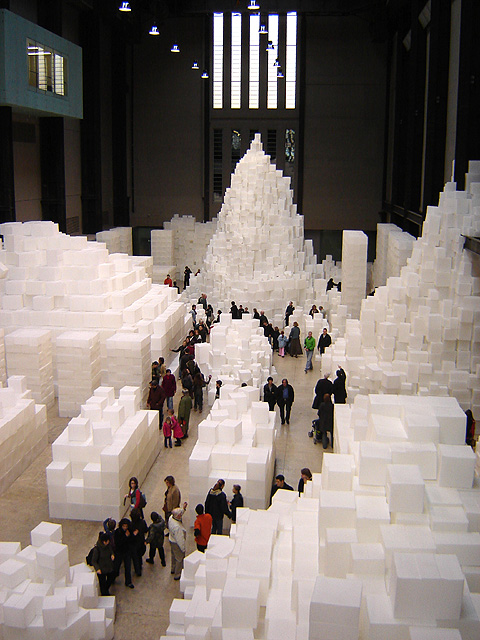|
Choi Jeong Hwa
Choi Jeonghwa (, born 1961 in Seoul) is an artist and designer whose work moves between the disciplines of visual art, graphic design, industrial design and architecture. His inspiration comes from popular culture and day-to-day life. Large-scale outdoor sculptures crafted from diverse materials such as consumer goods, balloons, wires, as well as recycled and found objects are the hallmarks of Choi's playful repertoire. Choi Jeonghwa is a globally recognized superstar artist, representing South Korea with an acclaimed international reputation as a contemporary artist. However Choi can be labeled in multiple ways — installation artist, art director, interior designer and art educator. He is most well-known for his role as the lead artist for the Korean Pavilion at the Venice Biennale, often referred to as the Olympics of the art world, and the widespread recognition of his installation piece“Alchemy'' at the main hall of the Leeum, Samsung Museum of Art, featured in a video ... [...More Info...] [...Related Items...] OR: [Wikipedia] [Google] [Baidu] |
South Korea
South Korea, officially the Republic of Korea (ROK), is a country in East Asia, constituting the southern part of the Korea, Korean Peninsula and sharing a Korean Demilitarized Zone, land border with North Korea. Its western border is formed by the Yellow Sea, while its eastern border is defined by the Sea of Japan. South Korea claims to be the sole legitimate government of the entire peninsula and List of islands of South Korea, adjacent islands. It has a Demographics of South Korea, population of 51.75 million, of which roughly half live in the Seoul Capital Area, the List of metropolitan areas by population, fourth most populous metropolitan area in the world. Other major cities include Incheon, Busan, and Daegu. The Korean Peninsula was inhabited as early as the Lower Paleolithic period. Its Gojoseon, first kingdom was noted in Chinese records in the early 7th century BCE. Following the unification of the Three Kingdoms of Korea into Unified Silla, Silla and Balhae in the ... [...More Info...] [...Related Items...] OR: [Wikipedia] [Google] [Baidu] |
Hongik University
Hongik University (, colloquially ''Hongdae'') is a private university in Seoul, South Korea. Founded by an activist in 1946, the university is located in Mapo-gu district of central Seoul, South Korea with a second campus(branch campus) in Sejong. In addition, Hongik University(Seoul campus) is universities in Korea. Hongik University has a bachelor's degree in art(paint & drawing) in South Korea. However, the university also offers a range of undergraduate and graduate programs. As of 2007, the university was home to 14,500 undergraduate students and 2,600 graduate students, and the undergraduate school consists of College of Fine Arts, College of Education, College of Engineering, College of Liberal Arts, College of Architecture, College of Law, and College of Economics and Business Administration. The graduate school provides research-based and practice-based programs in comprehensive fields including liberal arts, engineering, fine arts and design, education, economics, p ... [...More Info...] [...Related Items...] OR: [Wikipedia] [Google] [Baidu] |
Installation Art
Installation art is an artistic genre of three-dimensional works that are often site-specific and designed to transform the perception of a space. Generally, the term is applied to interior spaces, whereas exterior interventions are often called public art, land art or art intervention; however, the boundaries between these terms overlap. History Installation art can be either temporary or permanent. Installation artworks have been constructed in exhibition spaces such as museums and galleries, as well as public and private spaces. The genre incorporates a broad range of everyday and natural materials, which are often chosen for their " evocative" qualities, as well as new media such as video, sound, performance, immersive virtual reality and the internet. Many installations are site-specific in that they are designed to exist only in the space for which they were created, appealing to qualities evident in a three-dimensional immersive medium. Artistic collectives such as the ... [...More Info...] [...Related Items...] OR: [Wikipedia] [Google] [Baidu] |
Public Art
Public art is art in any Media (arts), media whose form, function and meaning are created for the general public through a public process. It is a specific art genre with its own professional and critical discourse. Public art is visually and physically accessible to the public; it is installed in public space in both outdoor and indoor settings. Public art seeks to embody public or universal concepts rather than commercial, partisan or personal concepts or interests. Notably, public art is also the direct or indirect product of a public process of creation, procurement, and/or maintenance. Independent art created or staged in or near the public realm (for example, graffiti, street art) lacks official or tangible public sanction has not been recognized as part of the public art genre, however this attitude is changing due to the efforts of several street artists. Such unofficial artwork may exist on private or public property immediately adjacent to the public realm, or in natu ... [...More Info...] [...Related Items...] OR: [Wikipedia] [Google] [Baidu] |


